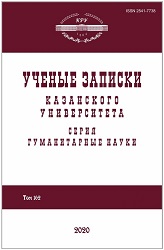Социальные характеристики животных в восприятии населения средневекового Поволжья
Social Characteristics of Animals as Perceived by Residents of the Medieval Volga Region
Author(s): Daniil Viktorovich PuzanovSubject(s): Anthropology, Cultural history, Middle Ages, Islam studies
Published by: Казанский (Приволжский) федеральный университет
Keywords: Abu Khamida al-Garnati’; beavers; animals; Aru; Visu; Volga Bulgaria; anthropology of nature; animism; analogism; Islam;
Summary/Abstract: Using theoretical developments in the field of anthropology of nature, the problem of perception of social bonds in beavers and other animals by residents of the Volga region was considered. It was noted that Abu Khamida al-Garnati’s description of the beaver community clearly goes back to the ideas of merchants of Aru or Volga Bulgaria. This type of perception of the animate nature is closer to the culture of Islamic civilizations, rather than animism. In Abu Khamida al-Garnati’s view, beavers were devoid of obvious cultural attributes, even such elements of animal culture that were recognized in the Islamic world. However, the strict opposition of the natural and social aspects in the modern world makes researchers see in this message something that is not in it. Nowadays, Abu Khamida al-Garnati’s message about beavers is commonly perceived as partly reliable or fantastic, but not because beavers were overhumanized (as researchers say). The reason is the peculiarities of functioning of the system, in which beavers, communities that hunted them, and countries of the East formed a single social network.
Journal: Ученые записки Казанского университета. Серия Гуманитарные науки
- Issue Year: 162/2020
- Issue No: 6
- Page Range: 47-57
- Page Count: 11
- Language: Russian

